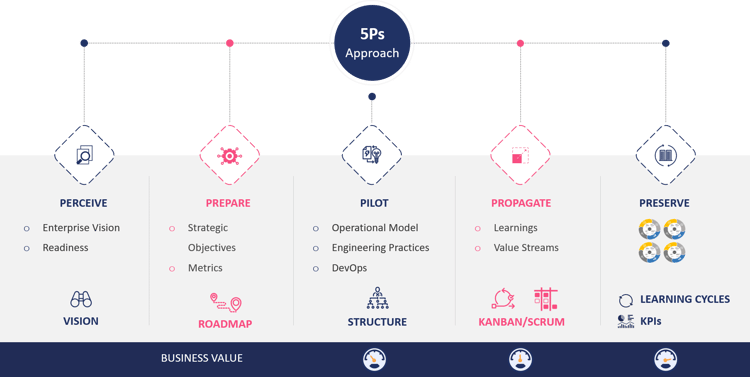The world around us is changing at an unprecedented rate. The ways of working that were prevalent earlier and had contributed to great success in several fields, cannot keep up with the demands of today.
What is needed, instead, is for companies to be enterprise agile and efficient at the same time, often having to optimize for one over the other.
Enterprise agility or the ability to respond quickly to rapidly changing market opportunities and needs, is regarded as a key enterprise capability today.
Most enterprises are already at some stage of their enterprise agile transformation journey. While a very small number of companies have found success, most have struggled with the return on investment made towards such transformations. In fact, as per one study, based on the parameters of productivity, gains from an enterprise agile transformation, measured across 150 companies, stood at a lowly 12%.
So why are most enterprises not seeing the kind of results they hope for and which, in most cases, is crucial for their very survival?
While each company, department, and team is different, we have come across 5 common pitfalls that enterprises get into when undergoing enterprise agile transformation.
“Let’s go agile!”
Pitfall 1: Undergoing an agile transformation without a clear business case
Some enterprises start out on their agile journey without linking it to tangible business outcomes. We have seen such journeys usually begin with a lot of energy but flounder soon. And finally, they break down at some point, when the business sponsor fails to see any ‘real’ progress. What makes matters worse is when agile consultants involved in such transformations limit their focus to getting team level agile practices in order, hoping everything else will magically fall into place.
What you can do:
- Agree on a vision
- Do not limit the transformation to agile practices
- Engage the right people to guide the transformation (beware of fake agilists!)
“Pilot done – what next?”
Pitfall 2: Not looking at an agile transformation as a strategic initiative
We have seen transformations initiated as a pilot and then fizzle out. This is because the pilot project receives all the attention and funding it needs and is usually time-bound. Once the pilot has run its course, the next steps are not clear. In some cases, since the pilot has run in an isolated and protected environment, it begins to falter at the point where it needs to interact with other parts of the organization. In other cases, there is no plan in place to carry through the transformation to other parts of the organization. The initiative ends with the pilot, and other teams and departments are left on their own to figure out the next steps.
What you can do:
- Execute the pilot in a realistic environment
- Think long term, and have a plan in place beyond the initial pilot
“We got this. We can do this on our own”
Pitfall 3: Leadership not on board
Any transformation that challenges the status quo is hard, even more so with agile transformations. It challenges the existing ways of working, involves hard decisions, and almost always requires a churn in people and their roles. Without the involvement of leadership, the new ways of working and their benefits largely remain confined to isolated pockets, sometimes even leading to sub-optimization at an enterprise level. Any large-scale transformation cannot be successful without the active involvement and support of leadership.
What you can do:
- Identify key leaders in the enterprise landscape and have them lead the change
- Involve leaders early in the transformation and ensure their engagement throughout the journey
“We have all that we need”
Pitfall 4: Not anticipating and investing in people and skills
Getting to true enterprise agility requires roles and skills that may not be immediately available in the enterprise. For example, for one of our industry leading customers, the transformation required someone to step up and play the role of a coordinator across 8 agile teams and to understand and respond effectively to the complexities in doing so. In another instance, business persons in a manufacturing setup who had worked in a traditional manner for decades had to adapt to a new way of slicing, framing, and discussing requirements rather than tossing over requirement documents to the development team. There are instances when people need to be hired to fill in specific roles that the target enterprise will have.
What you can do:
- Identify the roles and skills needed in the target enterprise structure
- Train people
- Consider hiring top talent
“Either my way or the highway!”
Pitfall 5: Department priorities at odds with the overall goal of enterprise agility
As enterprises grow, they become departmentalized and siloed (and for good reason). In order to enable enterprise agility, often parts of or entire departments are restructured or merged. This can lead to conflicting priorities and territorial battles, which can slow down and eventually derail enterprise transformation initiatives.
What you can do:
- Identify potential areas of conflict early in the transformation
- Put a resolution plan in place with the buy-in of leadership
- Have a plan B!
These are just some of the several challenges that enterprise transformations throw up. At Nagarro, the 5Ps approach to enterprise transformation specifically looks at these and over 200 other data points to actively identify and help mitigate such pitfalls, before they begin to undermine the transformation initiative.

Nagarro's 5Ps approach to enterprise agile transformation
To know more, drop us a line on agilecoe@nagarro.com




